WANT TO IMPROVE YOUR PUTTING?
CUT 5-10 SHOTS WITH OUR FREE GUIDE. DETAILS HERE
Best Tiger Woods Putting Tips to Improve your Technique
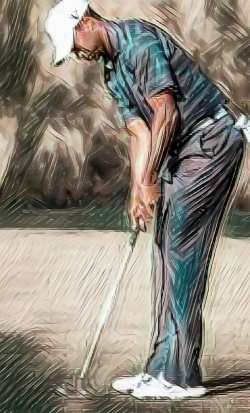
Here are 4 killer Tiger Woods putting tips to improve your:
Each of the tips below were part of my email putting newsletter. You can join this newsletter free here.Tiger Woods Putting Tips #1 - Improve your stroke path
Use an arc-shaped stroke with full release:
If you ever needed a model to believe that your putting stroke should NOT be a straight-back-straight-through motion, then look no further than Tiger.
Tiger's stroke is a clear in-to-in arc.
In chapter 1 of his "How I Play Golf" book, he focusses on putting and says that the stroke should go inside the ball to target line on the backswing and back to inside on the through swing.
Take a look at this picture from the book for a great mental image:
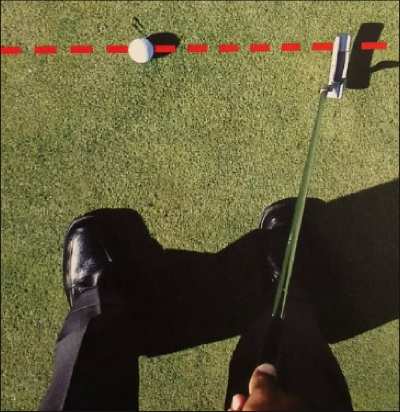
Tiger also states that he loves the feeling of his right hand - his dominant hand - releasing the putter head through impact.
His right-hand only gate drill with two tees set up at either side of his putter is designed to give him this feeling.
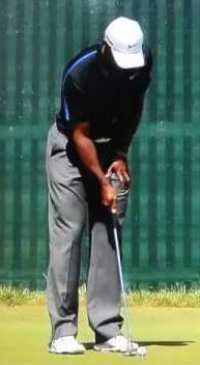
In an interview after his comeback Masters win in 2019 when talking about the short birdie putt at 16 after nearly holing-in-one that he feared he wouldn't release his right hand enough. (Re-watch those two amazing shots here).
I strongly recommend you give this right hand only drill a try. It promotes the release of the putter on an arc, will give you perfect center contact and a great feel for the weight of the putter head, which leads to great feel on longer putts.
(Remember it's always your lower hand you'd practice this drill with - so your left hand if you're left handed!)
Tiger Woods Putting Tips #2: Mental approach
"Putt to a picture"
Another part of Tiger's putting that can really help you in your play, starting this weekend, is to do what Tiger's dad taught him and "putt to a picture".
In other words, make your last look at the hole your "picture" and allow your subconscious brain to work out the rest. This gives you much better feel.
Renowned sports psychologist, Bob Rotella's mantra of "look and react to the target" is exactly the same principle.
The last thing you want when you take the putter back is conscious instruction to your hands and arms to move the putter "just about this hard".
No - let your instinctive feel for distance take over.
Look at how Tiger explains this in a clinic from 2004:
We have all inherited our ancestors' hand-eye co-ordination developed through thousands of years of hunting.
We are most effective when we use ability this unconsciously, just as if you were throwing a spear at your prey.
We need to be unconscious when we putt, just "putt to the picture" as Tiger says - look at the hole and react to it without conscious thought.
You'll be surprised how effective this is!
Tiger Woods Putting Tips #3: Quality of strike and roll
Short follow through for an authoritative strike
Tiger's stroke has a distinct hit.
As you can see from this video from the 2023 Genesis, his backswing is clearly longer than his follow through and there is clear "acceleration to the ball not past the ball like hitting a nail with a hammer".
The feeling of a hammer striking a nail is one of the best tips for gaining feel from Luke Donald, one of the few players to beat Tigers NCAA scoring average! Watch below to see more...
When you commit to this authoritative "strike" instead of a wafty stroke, you'll find you start your putts on line far better and will have a greater sense of distance. This is because you know your putter is going to be free wheeling when it makes contact with the golf ball, because you've got a short follow through in mind.
If your putter head is accelerating or decelerating at impact, it's extremely difficult to judge and leads to poor strikes, poor roll and poor distance control on long putts.
Imagining a shorter follow through than backswing, but with an authoritative strike forces your brain to have the putter moving at the right speed as it approaches the ball.
If your mental image is of massive acceleration through the ball with a longer follow through than a backswing, a definite strike and a shorter follow through will be counterintuitive, but it REALLY works to improve the speed of your putt!
Tiger Woods Putting tips #4:
"Hook your putts" like Tiger?
In February 2023 we marvelled as Tiger hobbled round at the Genesis Invitational to make the cut while clearly in discomfort.
Seeing Tiger - even injured - made PGA Tour golf a must-see - who knows how many more times we'll see him play?!
Although he played amazingly for someone with only one-and-a-half legs, Tiger's putting skills deserted him in round 2. This after making a lot of putts in round 1.
What he said in his post-round interview after his third round, in which his putter sprung back to life caught my attention:
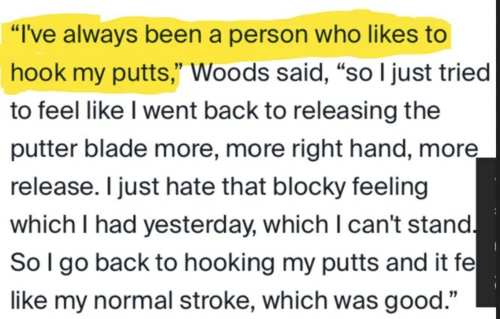
Hooking putts? Is this something we should consider?
Well, maybe...
Since my desire to become a consistently good putter started about 20 years ago, I've read and watched a lot of information and taken lessons from some of the best putting teachers in the US and Europe.
The names of certain legendary putters come up again and again:
Jack Nicklaus and Tiger Woods - of course - but also some whose putting really stood out from the rest of their game.
Players like: Paul Runyan, Bobby Locke, Ben Crenshaw, Luke Donald and Aaron Baddeley.
They all won tournaments against the best of their era; three of them won multiple majors: Runyan (2), Locke (4) and Crenshaw (2).
South African Bobby Locke still holds the record for victory margin in a PGA Tour event - he won the 1948 Chicago Victory National event by 16 strokes!
AND... Bobby Locke was also renowned for hooking his putts.
Take a look at how he's addressing this putt from the final round of the 1955 South African Open - the last of his 9 (!) victories in the event.
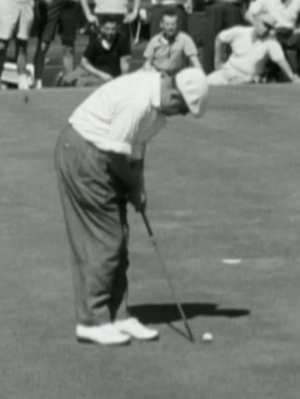
Clearly his stance is aimed miles right and from here he hooded the putter and pushed it through to the right of the target with a closed clubface and a short follow through.
So with Tiger and Bobby Locke, we have two of the greatest golfers of all time saying that they hook their putts. Why?
The aim is to get the ball rolling purely. Bobby Locke played on bumpy slow putting surfaces and you're probably thinking - "The greens were nothing like modern greens back then, you can roll the ball much more easily on modern greens and I don't need to hook putts any more!"
And you'd be partly right. Locke's stroke was an extreme version of a hook putting stroke - a long way inside the line and with an extremely closed putter face.
But since a slightly hooked stroke like Tiger's rolls the ball just as well as a pure strike, you're far better off erring towards a hook stroke rather than towards an out-to-in path with an open face.
A cut stroke looks like this:
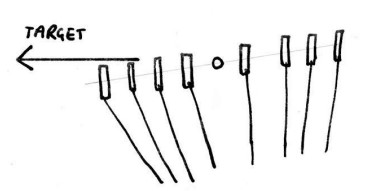
Sadly, this cut stroke produces lots of back and sidespin and gives you terrible roll which in turn leads to very poor judgment of speed.
So... you MUST AVOID a cut stroke at all costs!
Let's say:
- An out-to-in stroke with an open face costs a handicap golfer - conservatively - 5 strokes per round in bad roll and distance control.
- A perfectly square face and path gains you 3 strokes per round
- A hook-type stroke also gains you 3 strokes per round if you know how to adjust your aiming.
... Then should you err on the side of the hook stroke with the clubface slightly closed and the path of the stroke slightly to the right for a right hander (like below)?
I'd say so.
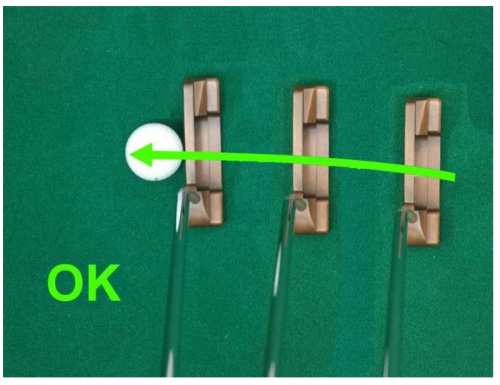
Tiger Woods Putting Tips #5: Pressure putting
What we can learn from Tiger's 2008 US Open putt?
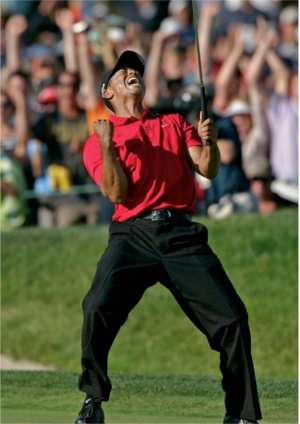
So here is one more favourite memory of Tiger's incredible putting and a lesson to learn from it.
It's his "Expect anything different?!" birdie putt on the 18th green at Torrey Pines in 2008 to draw level with Rocco Mediate and force a play off the next day.
Of course Tiger went on to win the play off and add another to his list of major championships before revealing two days later that he had a double stress fracture of his left tibia.
Basically a broken leg!
So, about the putt itself: The grandstands are packed as Tiger lines up this crucial putt.
Things haven't been going well for him who started the day with a two shot lead but doubled the first to fall right back into a tie.
His back nine has been far from his best, too.
He had the lead by one after a birdie at 11, but then made two bogies in three holes before standing on the 18th tee.
Then at the par-5 18th Tiger bunkers his tee shot, clearly in pain, and hits his second well into the US Open rough, throwing his club down in disgust.
A decent pitch later and he's 10 feet above the flag.
The greens are crusty as hell and the late afternoon poa annua grass is showing its characteristic bumpy spike marks.
He knows he needs this fast downhiller to reach a play off. Here's a video of the putt if you want to get back into the moment...
There are four key Tiger Woods putting tips in this "last chance saloon" putt:
1. Tiger's routine doesn't vary a jot from normal.
Despite the pressure-cooker of major tournaments, Tiger's methods and routine don't alter.
By following his routine, rather than getting caught up in the moment, he gives himself the best chance of making the putt.
Tiger treats all his putts as if they were important - I know having watched him up close while caddying in the same group. I noticed how he took the same amount of time in the final stage of his pre-putt routine - even the easy ones.
Sure this is an important putt, but Tiger later said he knew the only thing he could aim for was to put a good stroke on the putt and then take his chances.
All world's greatest professional golfers like Jack Nicklaus focussed on the things they could control and blocked out the rest. AND SO SHOULD WE!
I believe the amateur golfer misses pressure putts more often than they should because they get nervous and take too long over crucial putts. From this day on, resolve to take the same amount of effort ON EVERY PUTT.
This probably means you have to pay more attention than you currently do on short putts early in a round and resist the temptation to take too much effort on make-or-break putts later on.
The truth is that every shot and every putt IS equally important in a round of golf, so don't fall into the trap of thinking that the putt to win is anything special. I promise that consistency in your pre-putt routine will give you better results!
2. Don't fall into the trap of thinking you can control the outcome of any putt:
After the round, Tiger said he knew that all he could do was give the ball a good roll over the crusty green.
That means the greatest player in history was focussing on setting the ball off well. No magic was involved - he just focussed on rolling the ball well on one of the most important putts of his life.
You too should prioritise your stroke and your roll also, don't whatever you do peek at the hole and don't think you can force the ball into the hole.
The only things you can control in your putting happens between your two feet. So rehearse your stroke on the floor at home and notice how well the ball rolls if you make minor adjustments to your grip, grip pressure, stance and routine.
Next time you play, count how many great rolls you putt on the ball rather than how many putts you make. You'll feel better about your game and almost certainly hole more putts too.
3. Develop a Tiger-like feel for what speed gives the ball its best chance:
It's my belief that most amateurs hit their makeable putts too hard. As a result the ball has to hit the exact center of the cup to drop and this doesn't happen all that often.
Play too much speed and the comeback putts we're faced with are longer and harder, too.
You should generally try to use the whole of the hole. Watch the putt Tiger makes again and notice that his ball doesn't go in cleanly in the centre, but grabs a piece of the hole and isn't travelling so fast that it lips out.
That's the definition of perfect speed.
Tiger has developed this feel for perfect speed over decades of practice. You may not have the same number of reps behind you, but you can use this drill (LINK) to improve your feeling for the best speed to hole makeable putts at.
4. Ignore adverse green conditions:
Watch this slow motion view of the putt Tiger holed...
At this speed the number of bumps it takes is unbelievable.
But again - all you can do is concentrate on creating the best impact conditions you can to get great roll you can. This means working on the fundamentals of grip, stance and ball position. They're all covered in this article.
Most of us can't be bothered to work on the fundamentals like this and don't believe they'll make much difference.
In reality, there is no magic to putting, it's just getting the best possible impact conditions for great roll, having a great idea of how the ball goes into the hole and being consistent in your routine. That coupled with great green reading will make you one of the best putters you know!
So don't put your faith in some kind of magic, work on these essentials and the putts will drop! (These Tiger Woods putting tips will be a good start!)
Why I love Tiger Woods' putting so much
I was lucky enough to caddie in Tiger's group at the 1995 Walker Cup 18 months before his first Masters victory and it was clear - there and then - that he was a putting and short game sensation.
Ever since then I've been fascinated by the part of his game that most people look past - his short game. I believe it's this that makes him the most exciting player to watch even now when he's injured.
I've watched him up close and personal, and the Tiger Woods putting tips above are my lessons for you from his putting...
What is it about Tiger's putting that makes him perhaps the GPOAT (Greatest Putter of All Time)?
It's a combination of great technique to deliver the putter squarely and control speed, incredible feel for green reading and then the presence of mind to think clearly under pressure.
Although hard to match him, we can all get a bit closer by working on these crucial elements of our putting game!
(By the way, if you're interested in Tiger Wood's legendary Scotty Cameron Newport putter, I wrote a piece about it here)
by
 William John
William JohnSite Owner
P.S. I write much more than just Tiger Woods putting tips - see all putting tips here!
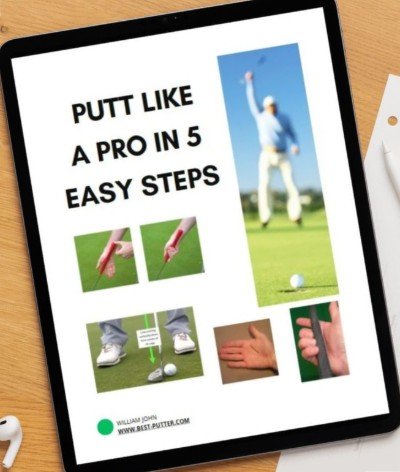 |
Return to the Best-Putter.com homepage
